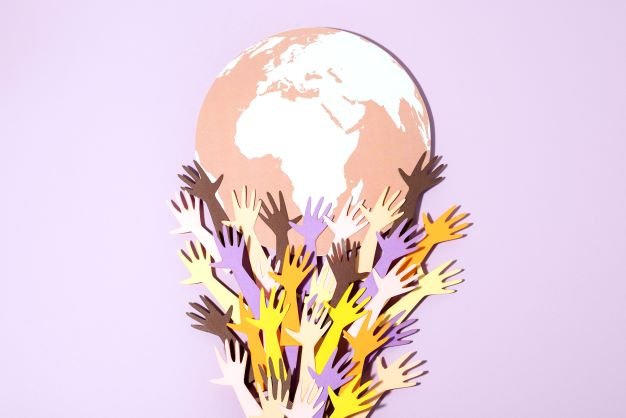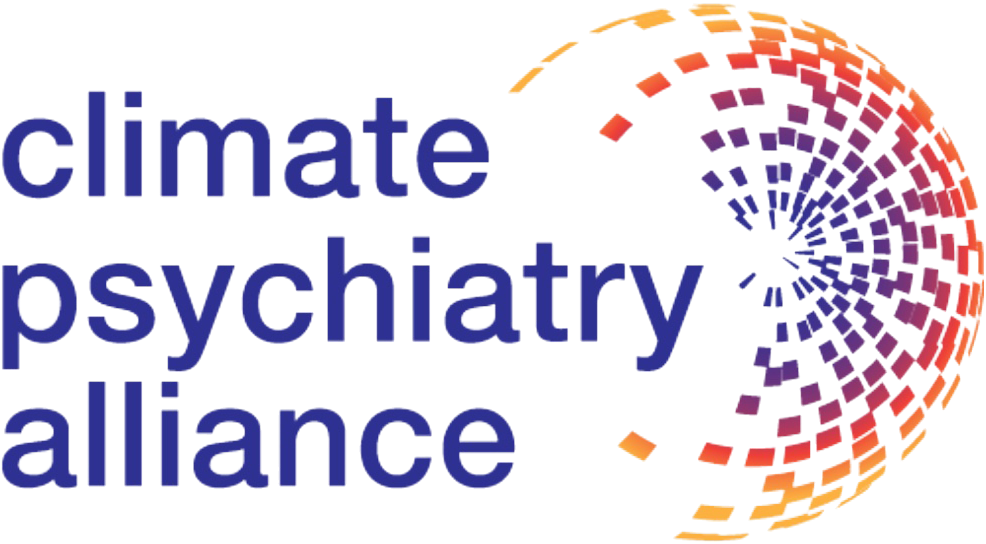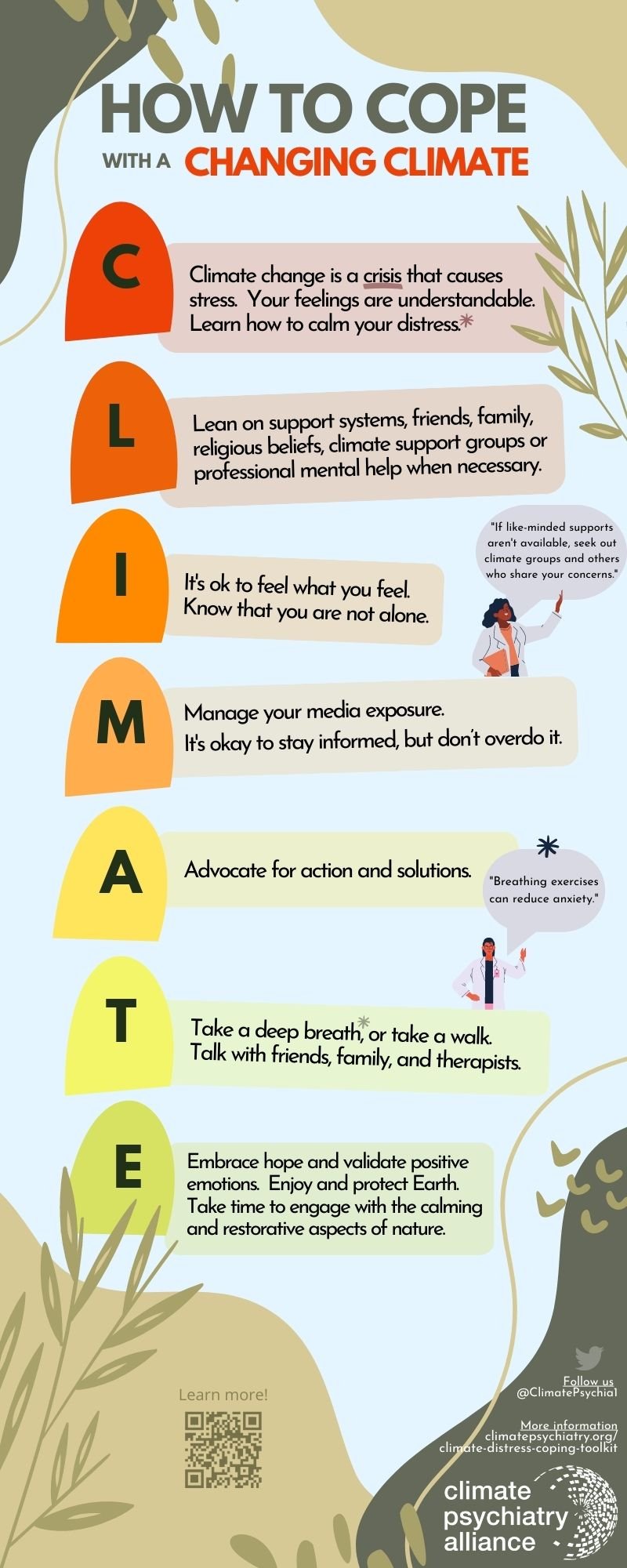Coping with Climate Distress
Climate distress is an increasingly prominent issue we are all facing. The CPA created this toolkit to assist you and others you care about in addressing the impacts of climate distress.
Check out the infographic, and then scroll down to dive deeper into the specific actions you can take.
This toolkit was created with contributions from Robin Cooper, Beth Mark, Janet Lewis, and Robert Feder for the CPA Steering Committee and CPA Member, Kate Niles.
-

1. Acknowledge your feelings
Identify and process the wide range of feelings
(sadness, grief, despair, anxiety, anger, numbness, even temporary periods of stagnation and disconnection, but also joy, pride, wonder etc).
Distressed feelings are normal in the face of real threats. In fact, our feelings can be utilized to mobilize us for concrete action.
Some wise thoughts on the matter:
“This is a dark time, filled with suffering and uncertainty. Like living cells in a larger body, it is natural that we feel the trauma of our world. So do not be afraid of the anguish you feel, or the anger or fear, because these responses arise from the depth of your caring and the truth of your interconnectedness with all beings.”
Johanna Macy, Buddhist scholar, environmental activist, workshop leader. The work that Reconnects
“When we push away our feelings, we risk …..losing our connection with our caring selves. “ Grief can make us come alive and point us towards life’s bigger purpose amidst climate breakdown”.
Brittany Wray, Climate scientist, researcher and author Generation Dread pg. 138
-

2. You are not alone
Embrace social connection
Isolation and loneliness plague many in our disconnected, fragmented current society. But, you are not alone, many others are equally challenged.
When feeling overwhelmed, it’s easy to feel isolated which fosters negative thinking. One of the best ways to combat loneliness and isolation is to find like-minded people and share feelings and ideas in safe spaces.
Check out these connection opportunities:
Good Grief Network - The Work that Reconnects
For those who get solace from spirituality, lean on spiritual beliefs and practices.
-

3. Cope / Calm the nervous system
Social connection which also gets called “mutual regulation” helps us calm our nervous systems. And we also have other ways to calm our nervous system.
Deep restorative breathing techniques can calm our nerves and help us to regulate. In particular: 4/7/8 breathing; is an effective technique. Here is a guided YouTube video which shows you how it’s done. Similarly, you could try Box Breathing. Finally, you can listen to ocean waves on shore going in and out – this is literally the ocean/earth breathing.
Integrate meditation practices into your life. There are many other versions of anti-anxiety meditations Some good Apps available on your phone include: Calm, Headspace, or Insight Timer. Additionally, Exhale is a free meditation app which targets BIPOC women.
-

4. Resist the tendency to catastrophize
Avoid only seeing the negative and thinking in black and white; that is, either/or or dualistic thinking.
Counter the negative, doom scenarios with what IS happening positively in the present. Remember that media thrives on negative stories. They do not always present the whole story.
Be aware of the counter-balancing stories: There is growing public awareness and concern, more and more activists’ groups forming, an explosive growth in clean energy solutions, scientists working on solutions and ways to respond, an increase in business climate-related investments and many legislative policies at the local, state and national level. Many people are busy! And hopeful!
Anxiety and grief can co-exist with positive emotions. ALWAYS remember this. One does not wipe out the other and in fact the former can motivate us toward change. Upsetting emotions do not have to be crippling or paralyzing.
Stay Present. A good way to do this is to watch a tree. It moves with wind, weather, and endures. You can do this too.
-

5. Foster reasonable, realistic hope
Hope is a verb.
“Genuine grounded hope comes from rolling up one’s sleeves, rather than watching other people do the work”. “ Engaging with like-minded groups with a common goal is one way to build collective hope” (BBC article)
Greta Thunberg scolded European MPs for failing to understand this. “You can’t just sit around waiting for hope to come. Then you are acting like spoiled irresponsible children. You don’t seem to understand that hope is something that you have to earn.”
“Real hope offers a chance of a more vibrant future; a glimpse, of something better than what we have today, not worse.” Katherine Hayhoe, PhD, climate scientist and Evangelical climate activist
“Radical Hope is stepping forward even when we don't know how we will do what we are called to do.” Janet Lewis, MD, CPA Steering Committee
-

6. Mobilize for collective, socially-engaged action
Join and participate in groups addressing climate solutions. Working with others is important for emotional support and decreasing isolation as well as mobilizing for real solutions. Too often we get overwhelmed by the enormity of the situation which contributes to retreating.
Start with something manageable. Don’t bite off more than you can chew. You can focus on tangible, local change which will contribute to your feeling that you can actually make a real difference
But also know that large solutions require mobilizing for effective policies ; so support engagement with political advocacy.
Find a group that matches your interests, talents, capacities and style.
Check out this BBC article sharing 10 simple ways to act on climate change
-

7. Replenish-Balancing our emotional ecosystem
Encourage positive emotions. Identify feelings of gratitude, pride, excitement, growth and knowledge; delight in solidarity with colleagues and partners.
Take pleasure in the small wonders. Watch sunlight DANCE on water! Watch videos of dolphins surfing!
Nature can be restorative; and fosters the wonder of the more-than-human. Spend time in the natural world, the outdoors. This is even possible in cities by seeking parks, small green spaces, and trees.
-

8. Seek professional help when needed
Do not ignore troubling signs when feelings are:
Overwhelming, uncontrollable, unregulated and intrusive
Causing you to feel suicidal
Interfering with your normal functioning and relationships
Resources:
For urgent help: Call the Suicide Prevention Hotline 988, or go to your local hospital emergency department,
Other less urgent resources: primary care provider, referrals from your friends, local mental health department
Check out the Climate Aware Therapist Directory
-

9. Share these additional resources!
Great online resources dealing with climate distress:
Emergency Preparedness for Older Adults: Stay Prepared, Stay Safe
Books:
Generation Dread: Finding purpose in an age of Climate Crisis. by Brittany Wray, PhD
A Field Guide to Climate Anxiety by Sarah Jaquette Ray.
Emotional Inflammation by Lise Van Susteren, MD
Taking the Heat by Bonnie Schneider
Children’s books:
Fur and Feathers Join Together by D. Grisworld and E. Reisfeld
Coco’s Fire: Changing Climate Anxiety into Climate Action by J. Wortzel and L Champlin


